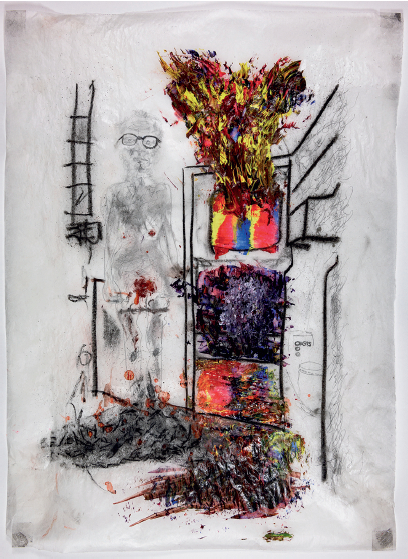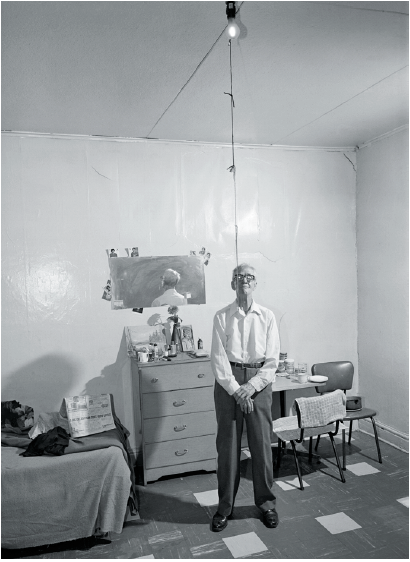Donigan Cumming
Donigan Cumming has long been recognized for his profoundly critical examinations of social documentary photographic practices. Over the past 30 years, he has established his own singular vision by turning the documentary tradition inside out. His theory-based investigations into the ontology of the photographic document and ethical implications of social documentary led him to a masterfully self-aware practice. Radically departed from the instrumentalization or simplification of the subject all too often found in anthropological typifications, Cumming’s photographic portraits capture his models as three-dimensional, complex agents impossible to contain in a singular image.
In the 1990s, the artist became increasingly dissatisfied with the muteness of the photograph. This frustration led him to experimentations with video, sound and photomontage in an effort to explore different avenues of representational manipulation through collection, combination and assemblage. In a lecture he delivered in 1999, Cumming noted that he is “driven by major, unresolved questions that [he] answer[s] differently at different stages of [his] own life.” In this perspective, the distinctive chapters in the artist’s career, marked by seemingly drastic changes in processes, ultimately remain linked in ways of making and thinking.

Donigan Cumming, Untitled (refrigerator in flames, drawn from a photograph taken of Nettie in her kitchen in Outremont), 2017, charcoal, pencil, watercolour, acrylic and adhesive tape on paper, 50.7 cm x 36.9 cm. Images courtesy Galerie Michel Guimont, Quebec.
In the past decade, Cumming has turned to drawing as a new means to reflect on his past work and to resolve his ongoing preoccupations and inquiries. This latest phase in his studio work started in 2007 as he was completing a residency at VU, an artist-run centre specializing in photography and located in Quebec City. Revisiting some of his previous black and white portraits, notably from his renowned 1986 series “Reality and Motive in Documentary Photography,” he started making tracings on vellum paper. These drawn explorations, directly inspired by the artist’s photographs, quickly turned into stand-alone works making space for memory and improvisation, translating the artist’s subjective state of mind while looking at the subjects he once photographed with a scientific rigour. Nicolas Bourriaud’s understanding of postproduction comes to mind here: by reusing and remixing facets of his own existing material, Cumming opened up a breach for renewed potential readings of his past and present work. This isn’t the first time that the artist had drawn from his own archives to create new works. He did so in his video arrangements in the 1990s and again in 2005 with his two monumental collages Prologue and Epilogue.
Coming full circle from his VU residency in Quebec City, the recent outcomes of Cumming’s developments were exhibited at his latest solo show at Galerie Michel Guimont, “La chambre d’Alfred et autres espaces.” Original photographic works from the 1980s were gathered in the gallery, with digitally altered prints of original contact sheets (from his “Twelve Sheets” series from 2013 to 2018) and a series of mixed-media drawings created in the past three years. Displayed among their photographic source materials, these drawings on translucent paper are evocative of the cliché-verre aesthetic, thus strengthening his ever-present commitment to the photographic medium.
Cumming’s processual relation to freehand drawing resonates with the performative. Characterized by a definite fluidity of gesture and palpable sense of urgency, they result from uninterrupted sketching sessions where the continuous pencil or charcoal lines barely leave the surface of the paper. Acting on quick creative impulses and with little regard for technical mastery, he scribbles and crosses out elements in an expressive whirlwind of mark making up until the point where he feels that the composition has revealed itself as complete. The resulting lines on the paper become direct markers recording the creative absorption ritual of the artist. The initial drawings are then enhanced with further sketchings and touches of colourful paint. Remarkably tactile, their varying textures override the smoothness of the photographic paper. The crinkled and vigorously torn vellum paper, accumulated pictorial matter and added strips of Scotch tape draw attention to the bold materiality of the works and the embodied processes that led to their creation. As opposed to their photographic counterparts, these drawings are imbued with an aura of singularity that could never be reproduced. The four variations on the same photograph of Alfred in his room on Kincora Street act as a great example of this sense of immediacy and perpetually renewed creative state of mind.

Untitled (June 16, 1983), from the series “Reality and Motive in Documentary Photography, Part 1,” 1986, gelatin silver print, 37.8 x 25.7 cm.
Pervading Cumming’s latest drawing series is the intimate human interrelations underlying each representation. Instead of trying to achieve a false sense of objectivity by keeping a cold distance from his subjects, the artist focuses here on the significance these encounters have played in his practice. Over time, Cumming has shaped his own pseudo-community of collaborators. Some of the models found in his photographs, such as Nettie Harris and Albert Ross Smith, had collaborated periodically with the photographer for years. The artist’s clear fondness for his former models becomes apparent in the soft rendering of their eyes, the point of contact between the two subjects. Moved by the nostalgic realization that all the models in the old photographs are now deceased, Cumming reinvents these long-lost spaces of encounter and gives them a second life through a subjective reactivation of their memory. At Galerie Michel Guimont, Untitled (Jim, Nora, Billy, Al, Bernard, and Patrick, drawn from four photographs taken in their rooms and apartments) appears as a tribute to this community by suggesting an erasure of the boundaries originally separating the subjects in order to bring them together in a common imagined space.
In searching for new ways of questioning the myth of the photographic truth claim, Cumming relies on the authenticity suggested by the spontaneous freehand drawing process. Ambiguous in their rendering, these drawings perpetuate the artist’s quest to short-circuit the narrative charge of the image. His visibly smeared fingerprints on the paper surface echo the indexicality of the photographic document, reminding us once again that he was there all along. ❚
“La chambre d’Alfred et autres espaces” was exhibited at Galerie Michel Guimont, Quebec City, from February 25 to March 18, 2018.
Michelle Drapeau is an author and independent curator based in Quebec City. She currently works as the assistant curator of Manif d’art, the Quebec City Biennial, and co-curator of “Images Rémanentes,” a public and permanent group show in Moncton.

